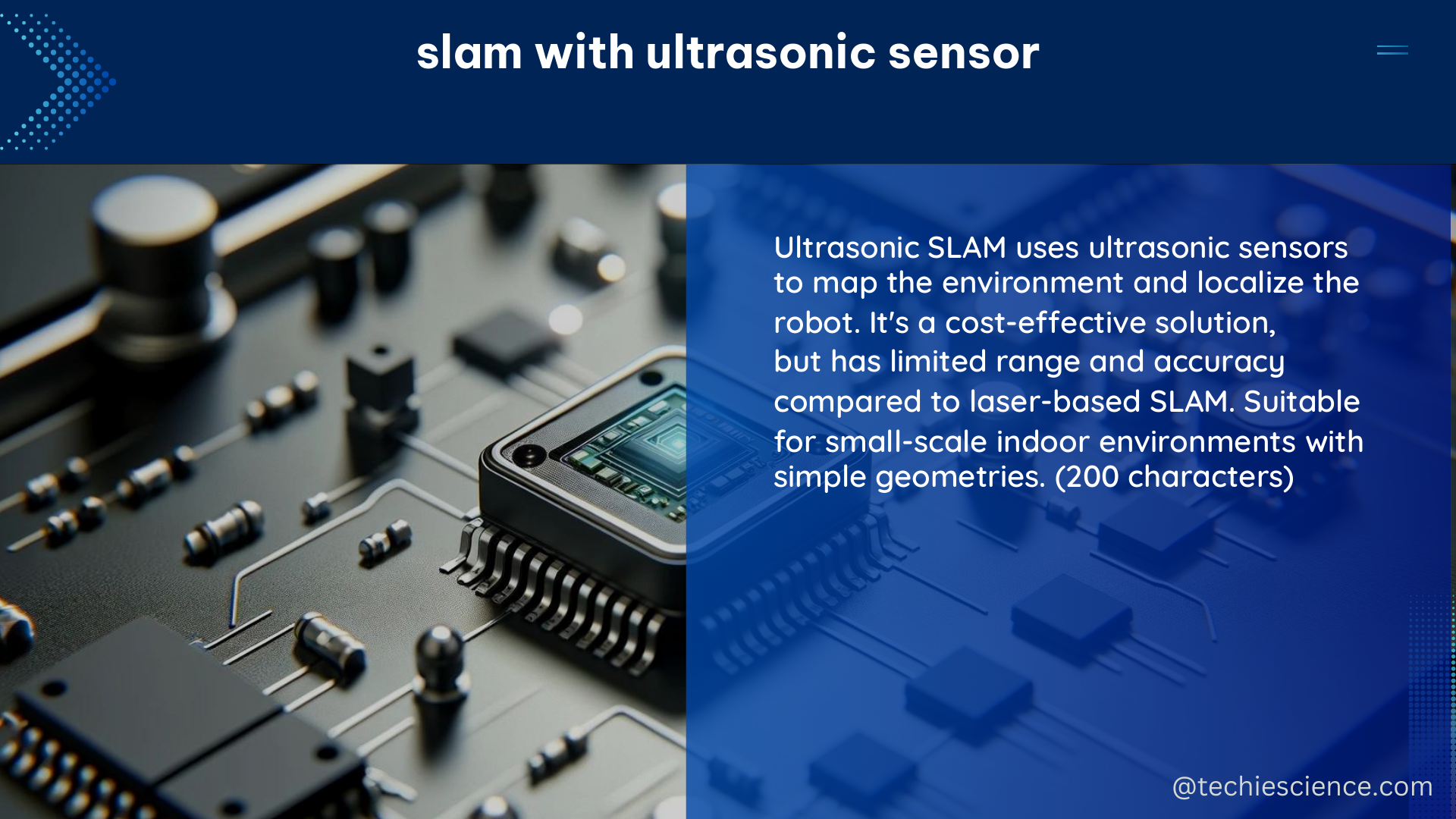SLAM (Simultaneous Localization and Mapping) with ultrasonic sensors is a powerful technique for mapping environments and determining the location of moving objects within those environments. This method is particularly useful in low-speed scenarios, such as parking lots, where high precision is required. By leveraging the time-of-flight measurements of ultrasonic sensors, SLAM algorithms can create detailed 2D maps and accurately track the position of a mobile robot or vehicle.
Understanding the Fundamentals of Ultrasonic SLAM
Ultrasonic sensors work by emitting sound waves and measuring the time it takes for the sound to bounce back after hitting an object. This time measurement can be used to calculate the distance between the sensor and the object. By using multiple sensors arranged in a specific pattern, it is possible to create a 2D map of the environment and determine the position of the object within that map.
The accuracy of SLAM with ultrasonic sensors depends on several factors, including:
-
Sensor Arrangement: The number and placement of ultrasonic sensors can significantly impact the quality of the map and the precision of the localization. Optimal sensor configurations, such as a circular or linear array, can provide better coverage and reduce blind spots.
-
Sensor Characteristics: The specifications of the ultrasonic sensors, such as their frequency, beam width, and sensitivity, can affect the range, resolution, and reliability of the distance measurements.
-
Environmental Conditions: Factors like temperature, humidity, and the presence of obstacles or reflective surfaces can influence the propagation and reflection of the ultrasonic waves, leading to potential errors in distance estimation.
-
Computational Resources: The processing power and memory available on the robot or vehicle can determine the complexity of the SLAM algorithms that can be implemented, as well as the frequency and accuracy of the updates.
Advanced Techniques for Ultrasonic SLAM

To enhance the performance of SLAM with ultrasonic sensors, researchers and engineers have developed various advanced techniques:
Sensor Fusion
Combining data from multiple sensor modalities, such as 2D LiDAR, laser range finders, and ultrasonic sensors, can significantly improve the accuracy and robustness of the SLAM system. A study has shown that using a recurrent neural network for data fusion can reduce the error in distance measurements by 46.6% and the standard deviation by 0.62m.
Probabilistic Mapping
Probabilistic approaches, such as Bayesian filtering and Kalman filtering, can be used to handle the inherent uncertainties in ultrasonic sensor data and provide more accurate and consistent maps. These techniques can account for sensor noise, environmental factors, and the dynamic nature of the environment.
Simultaneous Localization and Mapping (SLAM) Algorithms
There are several SLAM algorithms specifically designed for ultrasonic sensors, including the gmapping package and the Fast-SLAM algorithm. The choice of algorithm depends on the specific requirements of the application, such as the level of precision required, the size of the environment, and the available computational resources.
Adaptive Sensor Configurations
Dynamically adjusting the number and arrangement of ultrasonic sensors based on the environment and the robot’s or vehicle’s state can help optimize the SLAM performance. This can involve techniques like sensor placement optimization and active sensor management.
Robust Feature Detection
Developing robust algorithms for detecting and tracking salient features in the ultrasonic sensor data can improve the stability and accuracy of the SLAM system. This can include techniques like edge detection, corner detection, and feature association.
Practical Applications of Ultrasonic SLAM
SLAM with ultrasonic sensors has a wide range of practical applications, including:
-
Indoor Robotics: Autonomous mobile robots, such as those used in warehouses, hospitals, and smart homes, can utilize ultrasonic SLAM for navigation, obstacle avoidance, and mapping.
-
Autonomous Vehicles: Self-driving cars and other autonomous vehicles can employ ultrasonic SLAM for low-speed maneuvers, such as parking and maneuvering in tight spaces, where high precision is required.
-
Assistive Technologies: Ultrasonic SLAM can be used in assistive devices, such as smart wheelchairs and robotic walkers, to help visually impaired or elderly individuals navigate their environment safely.
-
Surveillance and Security: Ultrasonic SLAM can be used in security systems and surveillance applications, where the ability to map and track the movement of objects or people is crucial.
-
Industrial Automation: SLAM with ultrasonic sensors can be used in industrial automation, such as automated guided vehicles (AGVs) and mobile manipulators, for precise localization and navigation within complex environments.
Conclusion
SLAM with ultrasonic sensors is a powerful technique that offers a unique solution for mapping environments and determining the location of moving objects. By leveraging the time-of-flight measurements of ultrasonic sensors, SLAM algorithms can create detailed 2D maps and accurately track the position of a mobile robot or vehicle. Through the use of advanced techniques, such as sensor fusion, probabilistic mapping, and adaptive sensor configurations, the accuracy and robustness of ultrasonic SLAM can be further enhanced, making it a valuable tool in a wide range of practical applications.
References:
- Robust sonar feature detection for the SLAM of mobile robot. (2012). Retrieved from https://www.researchgate.net/publication/224623284_Robust_sonar_feature_detection_for_the_SLAM_of_mobile_robot
- Localization using ultrasonic sensors – Stack Overflow. (2011). Retrieved from https://stackoverflow.com/questions/7525053/localization-using-ultrasonic-sensors
- Optimization of a Simultaneous Localization and Mapping (SLAM) … (2023). Retrieved from https://digitalcommons.georgiasouthern.edu/cgi/viewcontent.cgi?article=1960&context=honors-theses
- SLAM with ultrasonic – ROS Answers: Open Source Q&A Forum. (2020). Retrieved from https://answers.ros.org/question/348155/slam-with-ultrasonic/
- SLAM in Low Speed Scenarios Using Ultrasonic Sensors. (2020). Retrieved from https://lup.lub.lu.se/luur/download?fileOId=9024869&func=downloadFile&recordOId=9024868

The lambdageeks.com Core SME Team is a group of experienced subject matter experts from diverse scientific and technical fields including Physics, Chemistry, Technology,Electronics & Electrical Engineering, Automotive, Mechanical Engineering. Our team collaborates to create high-quality, well-researched articles on a wide range of science and technology topics for the lambdageeks.com website.
All Our Senior SME are having more than 7 Years of experience in the respective fields . They are either Working Industry Professionals or assocaited With different Universities. Refer Our Authors Page to get to know About our Core SMEs.